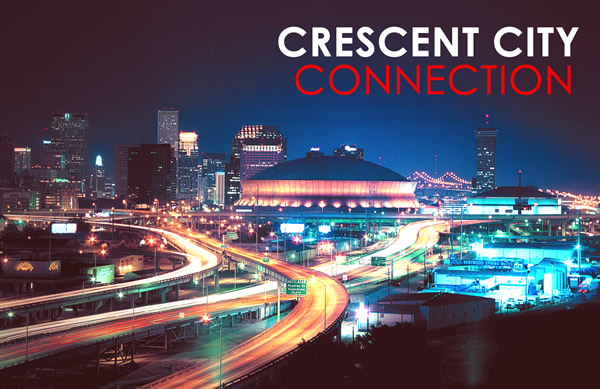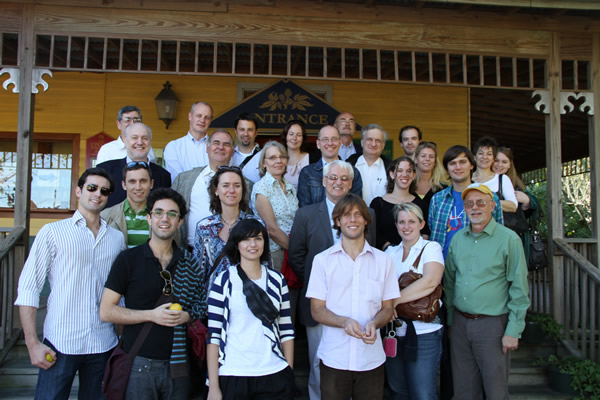Crescent City Connection
The Crescent City Connection in New Orleans refers to the iconic Mississippi river bridge that connects downtown New Orleans on the east bank of the river with the Algiers neighborhood on the west bank. It also serves as a symbolic marker for this year’s meeting of the Centers for Austrian Studies, hosted by CenterAustria at the University of New Orleans between October 27-30, 2010. After Austrian Centers in Minneapolis, Edmonton, and Jerusalem hosted the previous meetings, it was New Orleans’ turn to welcome Center directors along with graduate students to the Crescent City.
 Photo: www.neworleansonline.com
Photo: www.neworleansonline.com
The Federal Ministry of Science and Research in Vienna generously sponsored this event and was represented by its General Secretary Friedrich Faulhammer. The meeting once a year brings together faculty, staff and graduate students in Austrian and European Studies to present their latest research, to network, and to share their insights and experiences. This includes scholars from the established bedrocks of Austrian Studies in the United States at the University of Minnesota - Twin Cities and The University of New Orleans, as well as the Wirth Institute for Austrian and Central European Studies at the University of Alberta, Canada, the Center for Austrian Studies at Hebrew University, Jerusalem, Andrássy University of Budapest, Hungary, and the University of Vienna.
The conference program included several highlights, including the screening of a new film, Fulbright at Sixty: The Austrian-American Fulbright Program, 1950-2010, commemorating the 60th anniversary of the Fulbright program in Austria. In addition, participants were briefed by University of New Orleans faculty on Post-Katrina New Orleans, on Atlantic Hurricanes, as well as on New Orleans music. Other extracurricular activities included visits to The National World War II Museum, Jazz Clubs, and a plantation visit.
The majority of meeting time, however, was devoted to scholarship by the participants. Participating graduate students presented their research in the field of Austrian studies across a wide variety of disciplines and topics. Panel topics ranged from Borderland Travelers and Immigration to 19th Century Local and Transnational History, and Scientific and Identity Discourses.
The group was joined by Friedrich Faulhammer of the Austrian Federal Ministry for Science and Research, who spoke to attendees and guests about the current main challenges facing Austrian science policy. Specifically, the year of 2011 will bring increased funding for Austrian universities in the amount of 80 million Euros per year, based on fulfillment of specific conditions like more budget transparency at the university level, and regulation of student access to certain fields of study in the light of significant freshman admission numbers over the past years, Mr. Faulhammer explained.
At the same time, Faulhammer argued for an increase of private money in the publicly funded higher education system. The sharp increase in the number of students in particular poses additional challenges for Austrian universities. With no tuition and virtually no access barriers, issues like teacher-student ratios and infrastructure have moved center stage in recent debates in higher learning, highlighting the need for continued reform of Austria’s university system.
Recent efforts have been focusing on increasing the number of university graduates by decreasing not only the drop-out rate, but also via shortening the average length of study. What is more, the universities will also further increase their international cooperation, a field that they already successfully operate in, both on the European Union and extraeuropean levels. Intensifying this cooperation will also include efforts to increase interdisciplinarity at the same time.
Overall, the annual meeting of Austrian Centers brought about not only a friendly gathering for the exchange of ideas and research in one of America’s most unique cities, but also addressed issues pertaining to the future of Austrian universities and their work with partners abroad. “The Annual Meeting of Austrian Studies Centers has become a very valuable venue for networking among the leadership of Austrian Studies Centers from around the world and discussion and planning of future programs, as well as a showpiece of young scholars presenting their fresh new dissertation research”, explained Guenter Bischof, Professor of History and Director of CenterAustria at the University of New Orleans.
“This allows young scholars fortunate enough to be invited to these meetings to explore the “state of Austrian studies” in the world and learn about the variety of methodologies applied around the world in studying Austria – in other words, a nice interdisciplinary approach to Austrian Studies. The Austrian Ministry of Science and Research needs to be congratulated for its foresight to launch such an annual meeting and the Institute for Eastern European History at the University of Vienna for publishing the graduate student papers and the annual reports of Austrian Studies Centers directors in its series Europa Orientalis (LIT Verlag). The directors’ reports are an excellent documentation of the rich work of Austrian Studies Centers from around the world,” Mr. Bischof explained.
 The group visits Laura Plantation outside New Orleans, Louisiana. Photo: Gertraud Griessner
The group visits Laura Plantation outside New Orleans, Louisiana. Photo: Gertraud Griessner
